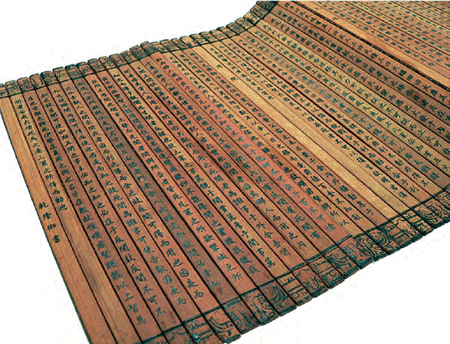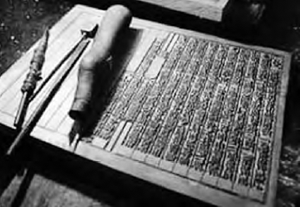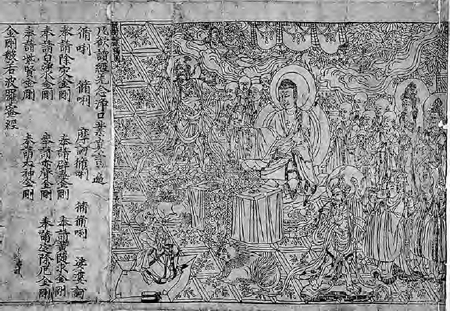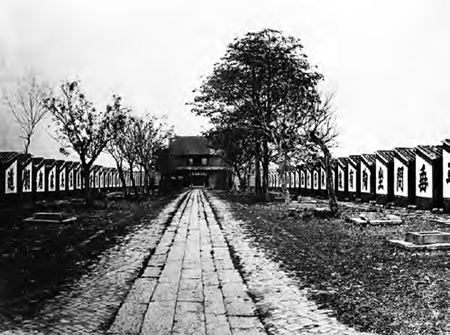Jaarboek voor Nederlandse Boekgeschiedenis. Jaargang 20
(2013)– [tijdschrift] Jaarboek voor Nederlandse Boekgeschiedenis–
[pagina 48]
| |
 | |
[pagina 49]
| |
Frederick Nesta
| |
[pagina 50]
| |
gave access to the outside. Movable type printing required printers to be near capital and intellectual markets and in urban centres where the distribution of large numbers of newspapers and books would be economical. Xylography could satisfy an extensive market of hundreds of thousands. Wood blocks could print about 5,000 copies before they would need to be refurbished or recut. Xylography simply was not able to reach the millions that the Western missionaries wanted to reach or that the large commercial publishers of Shanghai did reach in the years after the introduction of new demand into China. The focus of this chapter will be on Western scholarship, since it is accessible to those who do not read Chinese and because its broader scope allows for some comparison to Western print culture.  Figure 2. Woodblock carving required simple tools
| |
Scholars and woodblock printingThe cultural differences between China and the West are quite apparent in Chinese print culture. In Europe the watershed point for book history is the middle of the fifteenth century, when Gutenberg developed movable type, cheapening the costs of book production for publishers, book acquisition for readers, and giving authors a larger audience. China's history is far older. Not only did China enjoy the advantages of low-cost printing centuries before Europe, but the Chinese also had a cheaper alternative to papyrus and vellum. Paper did not appear in the West until the thirteenth century, centuries after it had been invented in China. Attributed to Cai Lun in the second century, paper made from bamboo or other fibres replaced the earlier Chinese media writing on bamboo slips or silk fabric. Printing in China developed in the ninth century. Based on woodblock printing, eminently suitable for a character-based language, it relied on a technology that was far cheaper than European movable type printing. Movable type printing in China, using clay type in a wax frame, was invented in the middle of the eleventh century and attributed to Bi Sheng (990-1051). Because of the complexity and | |
[pagina 51]
| |
number of Chinese characters, movable type was too expensive for widespread adoption.  Figure 3. A page from the Diamond Sutra, the earliest dated printed book, printed in 868
Producing a woodblock text required little in the way of capital or even of skill: carvers need not be literate but had only to follow the outlines left on the block, and, like European stereotype plates, the blocks were reusable, tradable, and transportable. Although early woodblock printing was for short devotional texts and talismans, it was soon extended to longer texts in every field. China's early and extensive bureaucracy and the examination system that screened candidates to fill it required a large and literate population that in turn needed affordable texts to prepare for the examinations. Begun in the early seventh century and lasting until it was abolished in 1905, the examination system was expanded during the Song Dynasty (960-1279) so that China was governed by cadres of scholars who came from every strata of society and every region of China. Candidates were tested on their knowledge of the Confucian classics, writing set essays for each exam and moving upward from county to provincial to imperial level exams. Those who passed the exams were rewarded with commensurate positions in the civil service. Scholars who failed in the examinations or literati who needed extra income also provided a skilled labour force that in its own turn produced histories, guides, almanacs, medical texts and other works that were affordable and that could be aimed at broader markets than similar publications in Europe. China's rivers, canals, and extensive internal trading network disseminated publications over a wide range and | |
[pagina 52]
| |
the shared Chinese characters made texts readable to those who spoke different dialects or even different languages. Whether there was a ‘print revolution’ in China similar to Elizabeth Eisenstein's ‘print revolution’ in Europe is a matter of debate, as is the extent of literacy and the affordability and availability of printed books. The first dated printed book in China is the Diamond Sutra of 868, but there is nothing that seems to have the impact in China that Gutenberg did in the West. Manuscript culture continued alongside print in China until very recent times, in part because of the scarcity or expense of texts and in part because of cultural preferences for copying as a way of learning and for the appreciation of calligraphy as an art. Joseph P. McDermott argues that there was a point at which printed text eclipsed manuscript, at least in terms of numbers if not status. He cites recent studies in China that show that the majority of surviving texts in medicine and drama are in manuscript rather than print. Other studies show that titles in history, philosophy, literature and the Confucian classics become dominant in printed editions only after the middle of the sixteenth century.Ga naar voetnoot3 Studies of texts that survived in libraries do not, of course, account for all of the more popular or ephemeral material that may have been printed, but whatever the case, woodblock technology worked well for producing text in Chinese characters, there was a commercial market, and the cheapness of woodblock printing did mean that printed texts were far more widely available in China than in the West. It seems incongruous that after several centuries of studying the book in China, Cynthia Brokaw could in 2007 still say that ‘The study of the Chinese book is still in its infancy’.Ga naar voetnoot4 I believe Brokaw says this because of the enormous area that must be covered: twelve centuries of printing, the physical scale of China itself, its ethnic diversity, its encounters with other cultures, and in the difficulties of reconstructing a history when so few traces remain. Wars, fires, floods, and the humidity and insects of south China have obliterated many more treasures, some of which we only know about because of citations from other ancient sources. Kai-wing Chow's Publishing, culture, and power in early modern China (2004) has hundreds of footnotes for each chapter, each footnote referencing the fragments that he had to assemble to reconstruct the history of publishing in a rather recent era of Chinese history.Ga naar voetnoot5 Chow notes, as do others, that commercial publishers were looked down upon in China. Trading for profit was not seen an honourable activity, leaving little impetus for families to glory in their success or maintain the records of their houses. However, families did maintain genealogies, local governments produced gazetteers, and libraries preserved texts and produced catalogues, so not all is lost to us, although what may remain is only a citation or a name. | |
[pagina 53]
| |
Current studiesThe past ten years have seen several important studies published in the West and in China that have expanded our knowledge and pointed to new methods of investigation. Brokaw, cited above, provides a lengthier description of recent scholarship than this survey can attempt.Ga naar voetnoot6 What follows will provide a few examples that show the general direction Chinese book history has been taking and some of the fields it could explore in the future. Lucille Chia's Printing for profit: the commercial publishers of Jianyang, Fujian (11th-17th centuries), issued in 2002, indicates in its title some of the scale that must be dealt with in China.Ga naar voetnoot7 Her important work covers only one small region of China and three families that maintained a printing and publishing tradition over 600 years. Chia's study is a social history that is made possible in part because the productivity of her printing families meant that many examples of their work have survived, either in physical format or in descriptive format in catalogues of no longer extant collections. Chia also cautions that what has survived are mostly elite materials. Popular material, cheaply produced, found no elite private libraries to preserve it and few scholars to write about it. How much was published and what impact it had on society may never be known, but she believes that the publishers she studied did have a substantial popular market. Northern Fujian province is mountainous and isolated but rich in bamboo, thus allowing for the development of an extensive paper industry. Cheap paper made it a good location for publishing and the Fujian publishers soon became known for distributing cheap editions of everything from the Chinese classics to medical texts, popular collections of fiction and poetry, encyclopaedias, and school primers throughout China. Chia made use of the actual texts, examining over two thousand imprints or their catalogue surrogates. Genealogies provided her with another source, used in conjunction with generational names that could tie a name in an imprint to a family in a genealogy or linking a genealogy name to printers or writers in a text, although it was still frustrating as the genealogies would refer only to a man's scholarship or his community service or filial piety and never to his work as a printer or publisher. The genealogies did enable Chia to trace the kinship ties that bound these families together in their business and they provided information on social and economic conditions. Likewise, local gazetteers did not provide direct information on printing and publishing but did indicate the economic situation of the area, the number of schools and degree holders, but also showed some pride in the local publishing industry and the attention it gained from merchants outside the region. Although the region was known for its printing and paper, both were considered by contemporaries to be of low quality, with most government printers shunning the bamboo paper from the area as inferior for their enormous print projects. Without the pressures of external government demand, the local printers relied on developing strong family and commercial printing enterprises. The reputation for poor quality did not seem to affect the popular demand for Jianyang | |
[pagina 54]
| |
imprints. Whatever their quality, they had the advantage of being available and affordable. Civil-service examination students, which could have been several hundred thousand by the thirteenth century, formed one of the largest markets and gave the Jianyang publishers a national market. Students had to master the Confucian classics, the various commentaries on them, history, and poetry.  Figure 4. Examination halls in Guangdong province, 1873. Each candidate would write his examination within the confines of the small cubicle assigned to him
Dictionaries, writing guides, and collections of successful examination essays might also be purchased to supplement the required texts. Medical texts, usually containing prescriptions, were also popular with a lay audience as well as for professionals. What Chia was able to reconstruct depicts a vibrant publishing industry that sought out and supplied a national readership across several markets, low to high. It accommodated itself to wars, natural disasters, dynastic changes, foreign occupation, and changing literary tastes. Technological changes also occurred in the manner in which woodblocks were carved. A variety of styles was used in carving text, with value placed on flowing calligraphic styles that resembled manuscript. By the middle of the sixteenth century the Jianyang publishers were adopting a style known as the workman style: straight and thin lines that were easier to cut and that allowed more characters to be put into each of the vertical columns of text. Less skilled labour could thus produce more pages of text. The mechanical appearance of the texts did not make them popular with readers who appreciated the aesthetics of the older texts but did make more texts affordable | |
[pagina 55]
| |
to a growing market. Movable type was not unknown to the Jianyang publishers - Chia found about ten of the 1600 imprints she studied were printed with movable type - but it usually required government sponsorship to meet its high costs.Ga naar voetnoot8 Christopher A. Reed's Gutenberg in Shanghai. Chinese print capitalism, 1876-1937 (2004) covers the modern period and a time when there is more surviving data.Ga naar voetnoot9 The selection and interpretation of that data still leaves room for debate, but scholars studying the book in China in the modern age have more evidence to work with. Western books and Western technology are also brought into the story, making this more familiar territory for Western readers. In his opening Reed discusses print culture, print commerce, and print capitalism in the context of Chinese book history. Non-commercial publications - official and literati - were extensive but the overall market for books was large enough for commercial publishers to profit from it. The size of the literate population can only be roughly estimated. The female population was almost entirely illiterate but it is possible that as much as 45% of the male population or from 20% to 25% of the entire population in the eighteenth century was literate. Between the high and low estimates there could have been a market of 90 to 200 million people (out of a population of 450 million) in the late nineteenth century, a literate population that at the high end would have exceeded that of the literate population of the English-speaking world. Towards the end of that century many new influences were changing the nature of Chinese publishing. The demand for the Chinese classics was still strong but the examination system, still focused on Confucian classics, was under attack and finally abolished in 1904. Christian missionaries from Europe and America began opening colleges and introducing Western science, technology, literature and philosophy to China. Those colleges, secularised in the 1920s, laid the foundations for China's modern universities. There was now a demand for imported Western books and for translations of them into Chinese. Traditional xylography was unable to supply this large and multi-lingual market and its demand for modern graphics and photographic illustrations. Woodblock printing was basically a cottage industry that could draw on family resources for the purchase of blocks and family labour for carving, printing and distribution. Printing with movable type, stereotype, or lithography required substantial capital and expensive and highly skilled labour. The Protestant missionaries, who wanted to reach the millions of the Chinese population, found that woodblock printing was not adequate for printing tens or hundreds of thousands of Bibles or tracts. The missionaries not only had religious zeal, they also had the capital to produce or import Chinese type and to establish presses in China. By the end of the nineteenth century, China also had its own capital markets and a cadre of Chinese compositors and printers, many trained at the mission press, began to operate their own presses. The centres of printing had shifted from southern China, first to Beijing and then to Shanghai, where Western settlements had made it into a cosmopolitan city that had an insatiable demand for books, and perhaps more importantly, for newspapers and magazines. Shanghai was not far from Jianyang but it was not a rural province of small villages but a city that grew from 230,000 in 1842, when | |
[pagina 56]
| |
the Treaty of Nanjing forced China to accept foreign settlements in its major ports, to a city of one million by the end of the century. The Chinese government was leery of Christianity and had banned it in 1724. Until the Treaty, Christian missionaries worked secretly within China or worked more freely outside of China, primarily in Malaysia and Macau. There were many early discussions within the missionary community of the advantages and disadvantages and relative costs of xylography, lithography, and movable metal type. Walter Henry Medhurst (1796-1857) computed the costs of printing a two thousand copy run of a Chinese Bible. He estimated that printing it using xylography would take three years and cost £1,900 in labour and materials, lithography would take two years and cost £1,262 and metal type would take one year and cost £1,515. Despite its higher cost, type was preferred because at the end of the print run the Chinese woodblocks or stone lithography blocks would be worn out while the type could be reused or recast. With the greater freedom allowed to the missionaries after the Treaty of Nanjing, missionary presses expanded rapidly. In 1844, when the Treaty of Wangxia forced China to grant concessions to the Americans, the American Presbyterian Mission Press (apmp) began work in Macau using Chinese workmen and a French type by Marcellin LeGrand that combined the 214 Chinese radicals, the roots of many characters, with another 1,100 characters, thereby allowing for the printing of compound characters. Enlarged to 3,000 characters cut by Chinese students in France, the LeGrand font could produce almost 23,000 characters. The apmp soon moved to Ningbo on the mainland and enlarged its activities, adding a type-casting furnace in 1846. In 1858 William Gamble arrived at the apmp in Ningbo and revolutionised the type process by creating new Chinese matrices by electrotyping and improved composition by designing a new and more efficient arrangement of type cases. By 1876 the apmp had moved to Shanghai, employed up to eighty Chinese workmen, and was using and selling to others typefaces in Chinese, Japanese, Manchu, and English. In the 1890s the apmp hired three graduates of one of its mission schools, Xia Ruifang, and the brothers Bao Xian'en and BaXianchang. In 1897 these three would leave apmp and found Commercial Press, one of the three presses that would dominate Chinese publishing. The impact of foreign missionaries on the development of the book in China cannot be underestimated. The missionaries began distributing Chinese translations of the Bible in the 1820s but it was the introduction of Western printing presses and Western science and concepts of government, spread through the journals published by the missionaries in Shanghai and Canton that would revolutionise China. The spread of the mission colleges provided opportunities for young and often poor Chinese boys, and even for Chinese girls, to get an education, learn new Western technologies Western medicine, and Western philosophies. Their teachers could also learn from the Chinese: one among them was James Legge, the Scottish missionary who translated the Chinese classics for the West. One of the students was Sun Yat-Sen (1866-1925), who would become the father of the new Chinese republic. Sun was financed in part by Charlie Song, also educated by missionaries. Song made the start on his fortune by printing Bibles for the missionaries and used part of his fortune to support Sun Yat-Sen and his revolution.Ga naar voetnoot10 | |
[pagina 57]
| |
The nineteenth century was a period of turmoil and humiliation for China. The Tai Ping uprising (1850-1864), instigated by a small Christian cult that grew rapidly in southern China, seized Nanjing, threatened Beijing and the Empire, and cost tens of millions of lives in warfare and starvation. Defeated by England in the Opium War (1839-1842), China lost Hong Kong and was forced to open its ports to foreign trade and settlement. An aggressive Japan seized Taiwan in 1894 and further pressure from England, France, Germany, America, and Russia threatened China with division into areas under foreign control. Chinese students began to travel to Japan to study the reasons behind the rise of Japanese power and to Europe and America to learn new technologies to modernise the Chinese military. Jonathan Spence, in his history of modern China, outlines the importance of translation in the building of a new China. Spence focuses on Europe as the source of much of this activity, but, as Westad notes, Japan was also a key bridge between old and new.Ga naar voetnoot11 China's modernisation began in the 1860s as Chinese students began to return from study abroad. Among them was Yung Wing, the first Chinese to graduate with an American university degree, a ba from Yale in 1854.Ga naar voetnoot12 Yung was commissioned to obtain machine tools from Europe and America, forming the basis of new arsenals in China. The arsenals, at Shanghai and Fuzhou, became technical schools and necessitated the translation of technical books for their students and faculty. In 1863 a translation of Henry Wheaton's Elements of international law (1836) was translated into Chinese and was successfully used by the Chinese in their dealings with Western diplomats. Three hundred copies of the translation were printed by the Imperial court and distributed to provincial officials. The Chinese government also began opening language schools and in 1867 were able to expand one of the schools into a college that taught science and International law.Ga naar voetnoot13 Another translator was Yan Fu, who went to England in 1877 to study naval technology at Portsmouth and Greenwich and who produced translations of Huxley, Mill, Montesquieu, and Adam Smith.Ga naar voetnoot14 Marxism first appeared in print in China in 1899, but the Communist manifesto was not published in a Chinese translation until 1906 and then only as a summary.Ga naar voetnoot15 Translations of Marx also came from Japan by 1910. The Chinese revolution of 1911 was driven in large part by print, just as the ideology of the Communist Party and Mao Tse-Tung would use the dominance of their state-run presses to flood the nation with the Little Red Book. Developments in China since the 1980s have seen some many small independent publishing houses develop, but there are still almost 600 state-owned publishing houses and state control still remains. The literacy rate in China has risen to over 92% and visitors to China are usually amazed by the numbers who throng to China's super-sized book shops and book fairs. The annual book fair in Hong Kong, with publishers from Hong Kong, Mainland China, and Taiwan, has been attracting over 900,000 visitors annually for the past two years. | |
[pagina 58]
| |
Future directionsThe history of the book in China presents scholars with opportunities to study centuries of printing and publishing that was satisfied by a stable and appropriate technology followed by a period of revolution and change. Much remains to be done in studying the publishing and bookselling industries in the many regions of China, in the importation and translation of texts from outside of China, on the impact of Chinese texts on Southeast Asia, Japan, and Korea, and on the impact of texts from those countries on China. Many of the titles in English-language collections built up by nineteenth-century British residents in Shanghai and Hong Kong were published by Longman: a study of the export of texts from Longman and of scientific and other works from European publishers into China help us understand the transmission of ideas and technology from West to East. It would also help Western book historians to see what impact trade to Asia had on their own publishing industries. Besides studies of the first translations of Western texts into Chinese, some valuable insights could be gained by studying translations from Chinese into European languages. If the history of the book in China is not in its infancy, as Brokaw said, it is certainly a broad and fertile field for scholarship that would reward both East and West in its study. |
|

